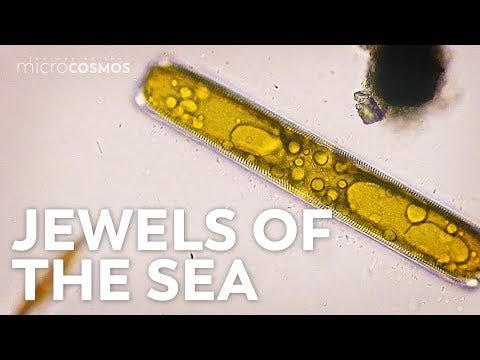Introduction
Diatoms are an extensive assemblage of unicellular algae that form colonies. They may appear inconspicuous to the unaided eye; however, their ecological, environmental, and industrial implications are substantial. Frustules are the intricate silica cell walls that give diatoms their distinctive appearance. Surpassing 10,000 species, diatoms have adapted to flourish in virtually all moist environments worldwide, including soils. Diatoms, which are ubiquitous in aquatic habitats, exert a crucial influence on ecosystem formation.
Biological Significance
Diatoms, members of the Bacillariophyta phylum, are renowned for the intricate and exquisitely patterned frustules comprising their silica cell walls. Diatoms deposit silica derived from dissolved silicic acid into their environment during growth and division. These microorganisms are not merely aesthetic marvels; they function as primary producers in aquatic ecosystems, extracting oxygen as a byproduct and utilizing sunlight to produce energy via photosynthesis. As photoautotrophs, they are also involved in carbon cycling and fixing carbon dioxide.
Interactions with Other Living Organisms
Diatoms engage in intricate interactions with various microbes within their ecosystems. They are a vital component of phytoplankton, where their population dynamics influence the overall structure and dynamics of marine and freshwater environments. These microscopic algae form the base of the food chain, providing sustenance for zooplankton and small fish. The relationships between diatoms and other microbes are critical to maintaining the balance of aquatic ecosystems.
Although diatoms are mainly aquatic organisms, they are distributed throughout soils worldwide. The activity of successive diatom generations shapes silica cycling and silicon availability in soils. Silicon is an essential beneficial element for plants like grasses, cereals, and rice, which confers resistance to diseases, metal toxicity, and other stresses. “Silicon influences water relations in drought-treated plants; it induces the formation of a silica cuticle double layer under the leaf epidermis, which reduces water losses through cuticular transpiration.” (Luyckx et al., 2017) The cumulative effects of diatoms depositing silica in soils over geological periods have also influenced the evolution of plants reliant on silica. Diatoms also improve soils by increasing the number of microbes that live there by secreting polysaccharides and other organic compounds. Their silica frustules also help store carbon for a long time. Interestingly, some diatoms can move along with plant roots. This brings their silica deposits into close contact with plant tissues, potentially fortifying the plants' cell walls against damage from herbivores.
Environmental Significance
The environmental significance of diatoms extends beyond their role in nutrient cycling and food webs. Diatoms act as bioindicators, reflecting changes in water quality and ecosystem health. “Through their photosynthetic activity, the group contributes to a massive 20–25% of the Earth's global primary production, carbon fixation, and oxygen release into the atmosphere” (Serôdio and Lavaud, 2020: Field et al., 1998; Sarthou et al., 2005) Monitoring shifts in diatom communities enables scientists and environmental agencies to assess the impact of human activities, pollution, and climate change on aquatic environments.
Habitat, Distribution and Global Presence
Diatoms inhabit many aquatic environments, from oceans and seas to lakes, rivers, and damp terrestrial habitats. They can be planktonic, floating in the water column, or benthic, dwelling on surfaces like rocks and sediments. This adaptability allows diatoms to thrive in diverse conditions, making them ubiquitous in aquatic ecosystems.
Diatoms can be found in virtually every corner of the globe. Their ability to flourish in marine and freshwater environments contributes to their widespread distribution. From polar ice caps to tropical waters, diatoms are integral to the global biosphere. According to Malviya et al.'s paper, Insights Into Global Diatom Distribution And Diversity In The World's Ocean, diatoms made up about 75% of the total photosynthetic community at station 11 (MS), more than 78% and 65% at polar stations 84 and 85, respectively (SO), 44% at subpolar station 82 (SO), and more than 38% and 44% at stations 122 and 123, respectively (Marquesas Islands; tropical SPO). They also made up 27.7% of all eukaryotic Photosynth (Malviya et al., 2016)
Industrial Applications
The significance of diatoms extends beyond their ecological roles; they have practical applications in various industries. Diatomaceous earth, composed of fossilized diatoms, is a versatile material used in filtration due to its porous structure. It is employed in water purification as an abrasive in products like toothpaste and insecticides. The unique properties of diatomaceous earth make it a valuable resource for multiple industrial applications.
Conclusion
Diatoms, with their microscopic beauty and ecological importance, are unsung heroes in the intricate tapestry of life. Their roles in nutrient cycling and oxygen production and as bioindicators underscore their significance in maintaining the health and balance of aquatic ecosystems. As we delve deeper into understanding these microscopic wonders, we unveil not only the secrets of the natural world but also tap into their potential for practical applications in diverse industries. The study of diatoms continues to enrich our knowledge of life's complexity and our interconnectedness with the delicate ecosystems they inhabit.
Sources
Field CB, Behrenfeld MJ, Randerson JT, Falkowski PG (1998) Primary biosphere production: integrating terrestrial and oceanic components. Science (80-) 281:237–240. https://doi.org/10.1126/science.281.5374.237
Luyckx, M., Hausman, J., Lutts, S., & Guerriero, G. (2017). Silicon and Plants: Current Knowledge and Technological Perspectives. Frontiers in Plant Science, 8, 256009. https://doi.org/10.3389/fpls.2017.00411
Malviya, S., Scalco, E., Audic, S., Vincent, F., Veluchamy, A., Poulain, J., Wincker, P., Iudicone, D., De Vargas, C., Bittner, L., Zingone, A., & Bowler, C. (2016). Insights into global diatom distribution and diversity in the world’s ocean. Proceedings of the National Academy of Sciences, 113(11), E1516-E1525. https://doi.org/10.1073/pnas.1509523113
Sarthou G, Timmermans KR, Blain S, Tréguer P (2005) Growth physiology and fate of diatoms in the ocean: a review. J Sea Res 53:25–42. https://doi.org/10.1016/j.seares.2004.01.007
Serôdio, J., Lavaud, J. (2020). Diatoms and Their Ecological Importance. In: Leal Filho, W., Azul, A.M., Brandli, L., Lange Salvia, A., Wall, T. (eds) Life Below Water. Encyclopedia of the UN Sustainable Development Goals. Springer, Cham. https://doi.org/10.1007/978-3-319-71064-8_12-1



